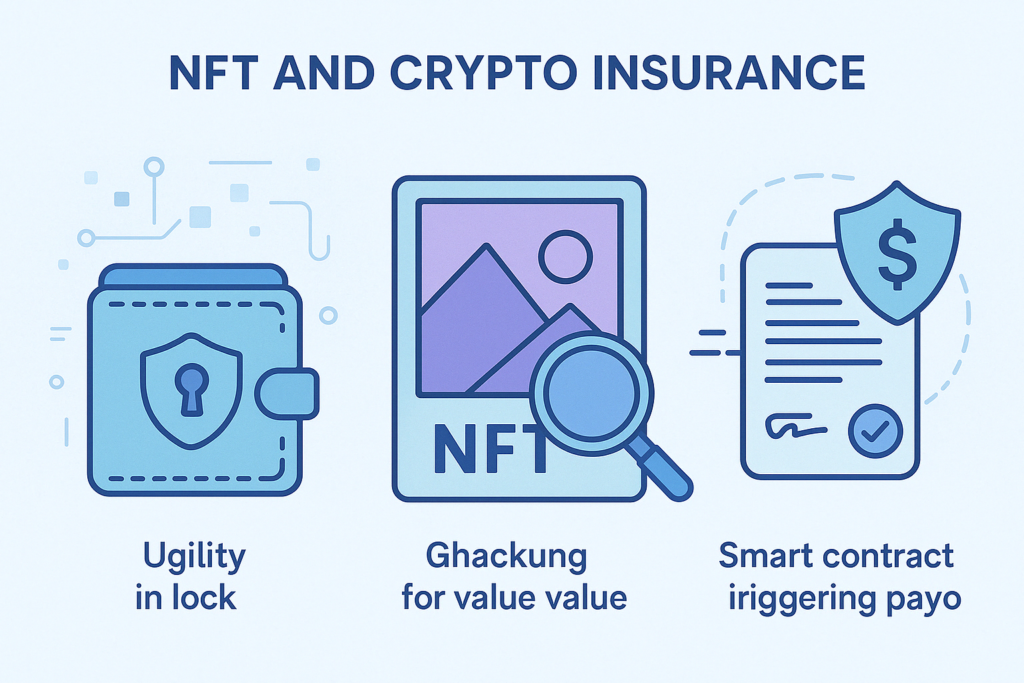
In a world where digital assets are rapidly becoming mainstream, the insurance industry is facing both a challenge and an opportunity: how to adapt traditional risk models to the decentralized, fast-moving world of blockchain. From crypto wallets to NFT collections worth millions, individuals and companies are now demanding protection for assets that only exist in the digital realm.
But what does risk management look like in a world of smart contracts and decentralized finance (DeFi)? In this article, we explore how NFTs and cryptocurrencies are reshaping insurance, and what the future of digital asset protection could hold.
What Are Digital Assets?
Digital assets are non-physical items with value that are stored digitally and often tracked on a blockchain. The most common examples include:
- Cryptocurrencies (e.g., Bitcoin, Ethereum)
- NFTs (non-fungible tokens—unique digital items like art, collectibles, or in-game items)
- Tokens representing shares, real estate, or access to services
These assets can be traded, sold, or stored securely in digital wallets, and their value can fluctuate significantly based on market demand.
The Problem: High Value, High Risk
As digital assets grow in value, so do the risks associated with owning them. Some of the most common threats include:
- Hacks and theft: Wallets and exchanges are frequent targets for cybercriminals.
- Smart contract vulnerabilities: Bugs or exploits can lead to loss of funds.
- Loss of private keys: If you lose access to your crypto wallet, the assets are gone forever.
- Valuation volatility: The value of crypto assets can drop or rise dramatically within minutes.
These factors have created a demand for insurance products tailored to the digital economy.
The Rise of Crypto Insurance
Traditional insurers have been slow to enter the crypto space, but that’s beginning to change. New and specialized insurance providers are stepping up to offer coverage for:
- Hot and cold wallet protection
- Smart contract failure
- Custodian theft or fraud
- NFT loss or damage (in digital terms)
Companies like Nexus Mutual, InsurAce, and Bridge Mutual are leading the way with blockchain-native insurance models, often governed by decentralized communities.
How Insurance Works in Web3
In Web3 (the decentralized internet), insurance can function through smart contracts. These are self-executing programs that automatically pay out when certain conditions are met. For example:
- If a smart contract is exploited and funds are lost, the protocol could trigger a payout automatically from a shared insurance pool.
- Users stake tokens in these pools and earn rewards in exchange for taking on risk—effectively becoming “underwriters” in a decentralized system.
This model removes the need for centralized approval and claims processing, which speeds up the payout process and reduces administrative costs.

NFT Insurance: More Than Just Digital Art
NFTs are often perceived as collectible art, but they can also represent music, video, event tickets, or even real estate ownership. As these assets grow in use and value, there is a growing interest in insuring them.
Use cases for NFT insurance include:
- Stolen or hacked NFTs (common in phishing scams)
- Loss of access to wallet holding the NFT
- Valuation disputes in the case of resale or inheritance
- Coverage for fractional NFT ownership
Imagine an NFT worth $500,000 being lost to a scam. Without insurance, the owner bears the entire loss. With a properly structured policy, recovery becomes possible.
The Role of Traditional Insurers
Some traditional insurance giants, like Lloyd’s of London, have started experimenting with digital asset policies. However, legacy insurers face major challenges:
- Lack of crypto expertise
- Regulatory uncertainty
- Difficulty in valuing digital assets
- Unclear legal frameworks around ownership and liability
Still, partnerships between tech startups and insurance incumbents are forming, aiming to bridge the gap and create hybrid solutions.
The Future: On-Chain Risk Management
We’re heading toward a future where insurance is:
- On-chain: Managed by smart contracts with real-time data feeds (oracles)
- Decentralized: No middlemen, governed by community voting and staking
- Dynamic: Premiums and policies that adjust automatically based on asset behavior
- Programmable: Embedded directly into NFTs, crypto wallets, and DeFi platforms
This could revolutionize how we think about protection—not just as a post-loss safety net, but as an integral part of owning and managing digital assets.
Final Thoughts
Digital assets are changing everything—from how we invest to how we manage risk. As cryptocurrencies and NFTs gain mainstream traction, the insurance industry must innovate to stay relevant. Whether through smart contract-based policies, NFT coverage, or DeFi-native insurance protocols, one thing is clear: the future of risk management is digital, decentralized, and already in motion.
Pro Tip: If you own valuable NFTs or crypto, consider researching decentralized insurance platforms like Nexus Mutual or InsurAce. Just as you wouldn’t leave a physical car uninsured, your digital assets deserve the same level of protection.




